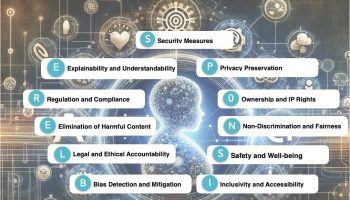Ethical AI is simple words is about ensuring your AI models are fair, ethical and unbiased.
So how does bias gets into the model. Let’s assume, you are building an AI model which provides salary suggestions for new hires. As part of the building the model, you have taken gender as one of the features and you are using the feature to suggest salary. The model is trying to discriminate salary based on genders. In the past, this bias has been going through human judgements and various social and economical factors ( https://en.wikipedia.org/wiki/Gender_pay_gap) but if you include this bias as part of the new model, this is a recipe for disaster. The whole idea is to build a model which is not biased and suggest salary based on people experience and merits.
Take another example of an application providing restaurant recommendations to a user and allowing a user to book a table. Now, while recommending new restaurants for the user, the AI application is designed to look at the amount spent in previous transactions and rating of the restaurant (along with other features) and the AI system start recommending restaurants which are costlier. Even though, there might be good restaurants is the vicinity and less costly, the restaurants may not show up as one of the top recommendations. Also more the amount spent by the user, implies more revenues for the restaurant application. So in short, you are steering a class of user towards spending more on high-end restaurants, without the user knowing about it. Does this classify as a bias or a smart revenue generating scheme ?
Ethical AI is great topic for research and debate as you would see a lot of development (as well as usual marketing buzzwords) and governance in this area.
So how do you ensure your model in Ethical and validate it ?. I am sharing my perspective below –
– Designing the model without bias – Ensure you don’t include the features that can make your model bias. For instance, don’t include gender while predicting the salary packages. Take time to validate the data sources and features being used to build the model.
– Explain the model output – Designing applications with explainability in mind should be a key design principle. If the user receives an output from an AI algorithm, providing why an output was presented and how relevant it is, should be built into the algorithm. This should empower users to understand why a particular information is being presented and turn on/off any preferences associated with an AI algorithm for future recommendations/suggestions.
– Validate the model – Validate the model with enough test cases. You will also see a lot of offerings (the Ethical AI services) crop up in future around this area. Again, the key is that offering/services needs to be Vertical focus (which understand the domain), rather than pure play horizontal AI services. (else it would end up like chatbots hype – https://navveenbalani.dev/index.php/articles/ai-chatbots-reality-vs-hype/ )
– Accountability – Ultimately humans needs to be look at the output from the AI system and take corrective action for critical task. I don’t see machine taking over human intelligence for critical tasks in future. For instance, a cancer treatment option thrown by an AI system needs to be carefully investigated by the doctor, but a fashion website recommending wrong products for a user is not critical and can be corrected later through feedback/learnings.
Going back to the restaurant application, if we design the application with the above guidelines in mind and make the output explainable to the user, we can at minimum have 4 levels of recommendations (shown as tiles in application), along with an evidence on why a recommendation is being provided –
- Recommending restaurants based on earlier restaurant spends ,ratings, history and preferences of the user
- Recommending similar restaurants which are highly rated and less costly based on ratings, history and preferences of the user
- Recommending new restaurants based on user history and preferences of the user
- Recommendations generated by the system without applying any user preferences.
The revised application now provides various recommendations and enough evidences to back up the recommendation and ultimately the choice is left to the user to pick up the restaurant and book a table.
The above was an example of a very simple application, but imagine when AI is deployed across industries and in government agencies, then developing and monitoring the AI system for ethical principles would be extremely critical. Both the creators of the model, as well as validators (agencies/third party systems etc) validating the model would be critical to ensure AI models are fair, ethical and unbiased.
As we are creators and validator of the AI system, the onus lies on us (humans) to ensure technology is used for good.


